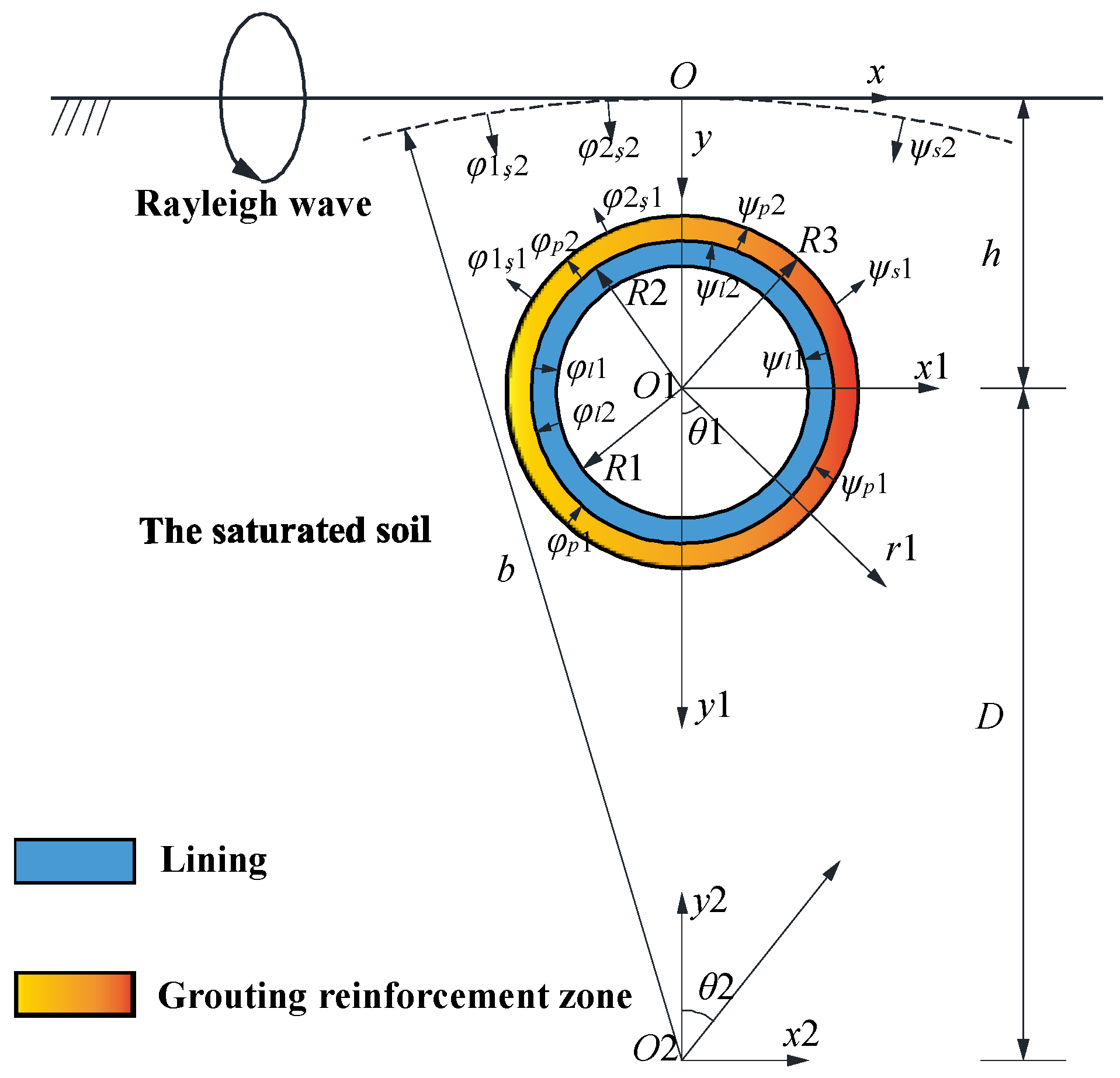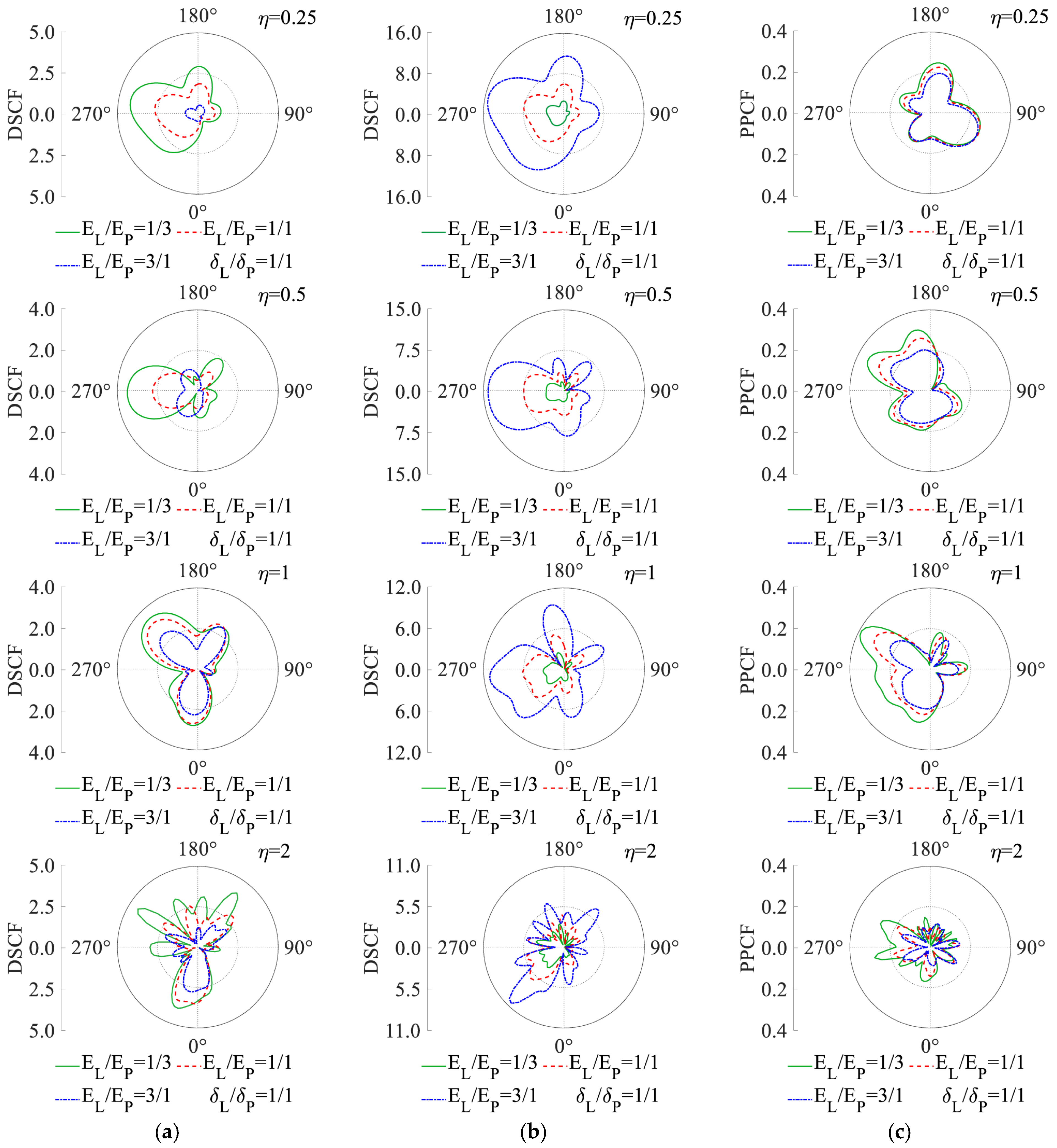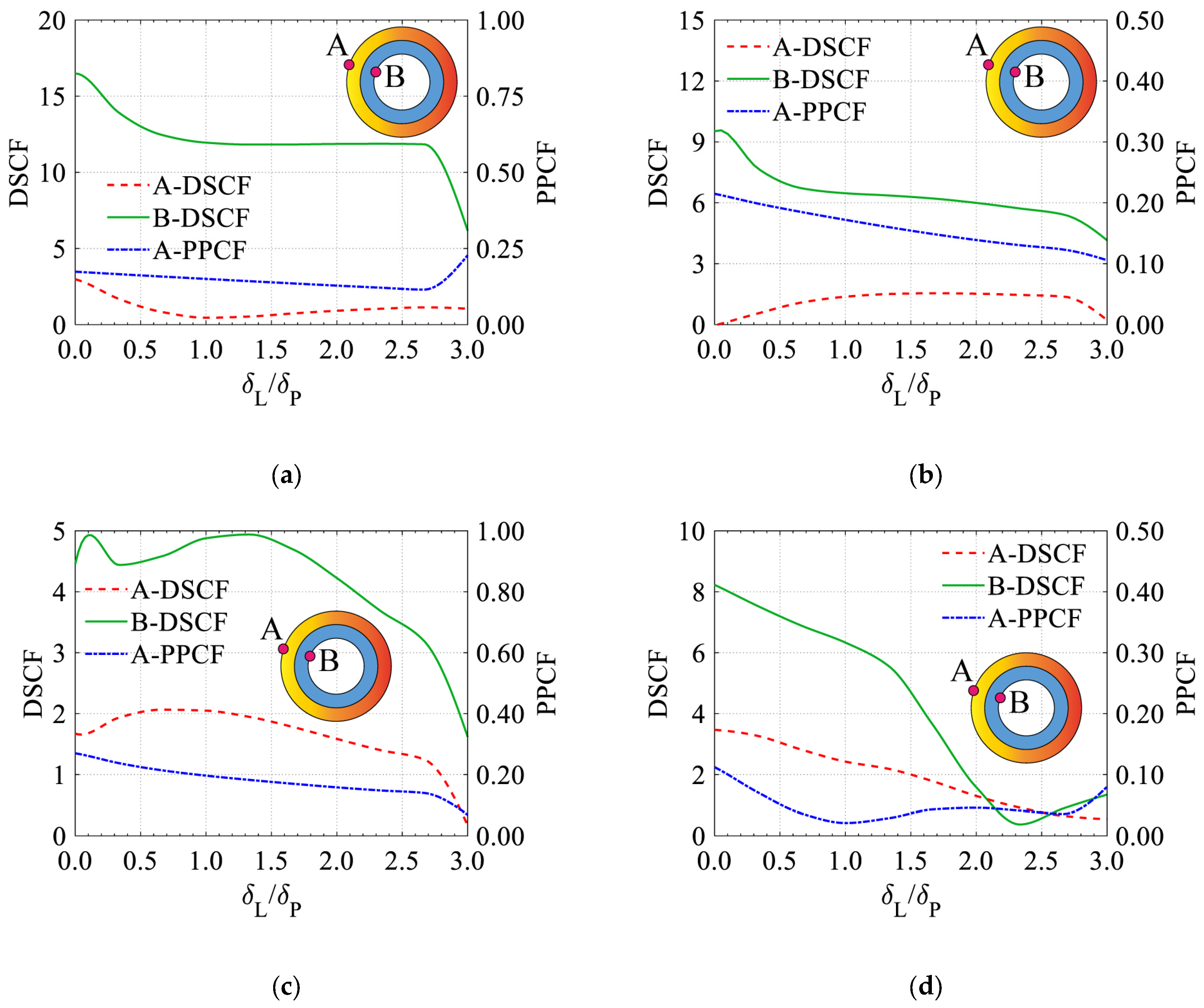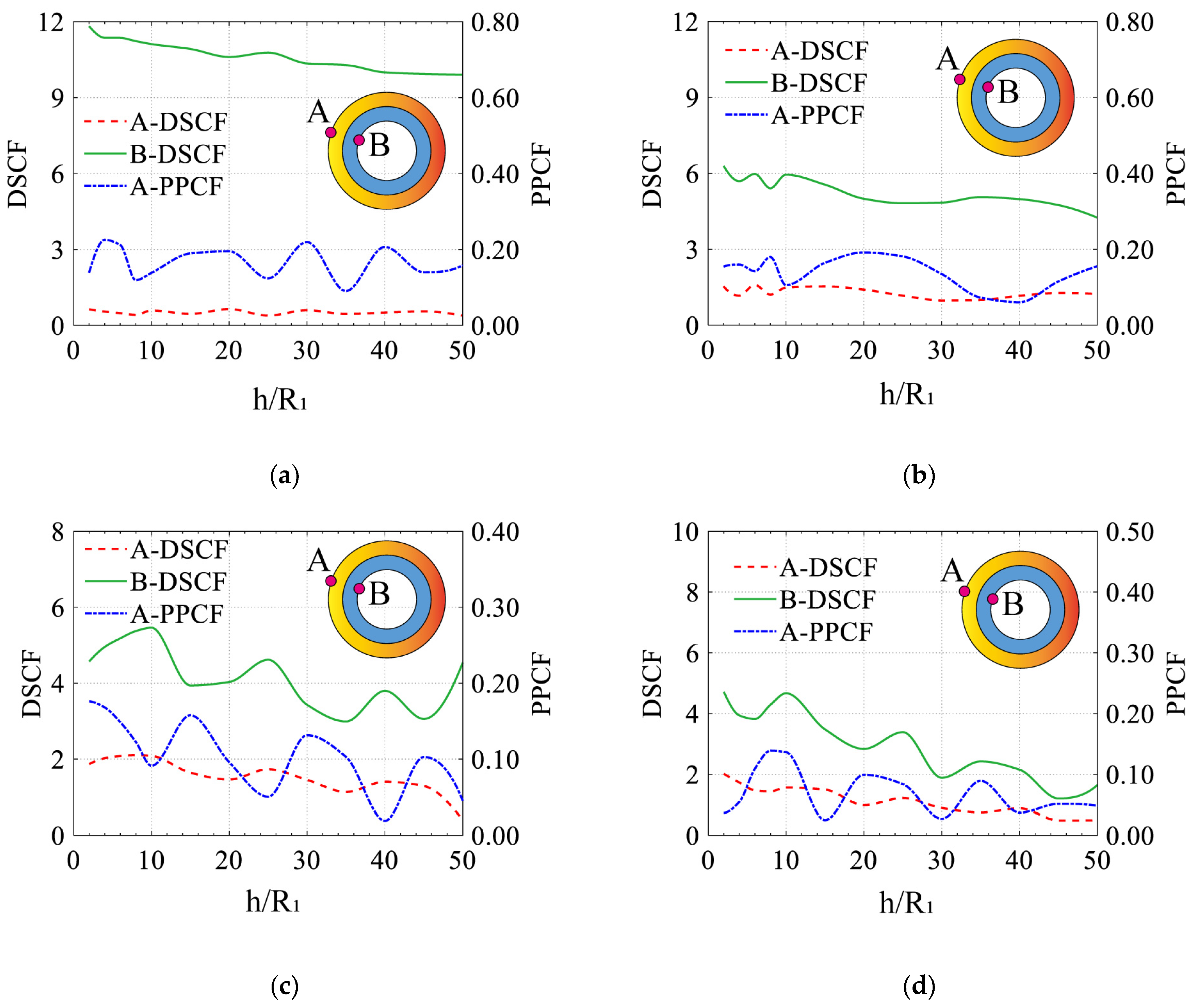Analytical Solution for Rayleigh Wave-Induced Dynamic Response of Shallow Grouted Tunnels in Saturated Soil
Abstract
1. Introduction
2. Theoretical Modeling
2.1. Biot Theory of Poroelastic Medium
2.2. Potential Function of Governing Equation
2.3. Incident Wave Field
2.4. Scattering Wave Field in Soil
2.5. Total Wave Field Potential Function in Saturated Soil
2.6. Scattered Field Wave Potential Function in the Grouting Reinforcement Zone
2.7. Scattered Field Wave Potential Function in the Tunnel Lining
3. Boundary Conditions and the Solutions
3.1. Boundary Conditions
- Stress boundary condition at the surface of saturated soil;
- Displacement boundary condition at the interface between saturated soil and grouting reinforcement zone;
- Stress and displacement boundary conditions at the surface of the grouting reinforcement zone;
- Displacement boundary condition at the interface between grouting reinforcement zone and tunnel lining;
- Stress boundary condition at the interface between grouting reinforcement zone and tunnel lining;
- Stress boundary condition at the free surface of the lining;
3.2. Displacement and Stress Expressions
3.3. Processing of the Coefficients of Iincident R-Wave Potential Functions
3.4. Coefficients Solving
4. Numerical Results and Discussion
4.1. Model Verification
4.2. The Material Properties for Numerical Examples
4.3. Results Analysis
5. Conclusions
- (1)
- Incident frequency governs both the spatial distribution and magnitude of DSCFs and PPCFs. Low-to-medium frequencies (η = 0.25–0.5) amplify stress concentrations at the lining crown (DSCF = 7.2–12.1) and sidewalls (DSCF = 14.2–15.9), while high frequencies (η ≥ 1) shift stress peaks to the invert and foot arch regions (DSCF = 9.6–10.9). PPCF magnitudes diminish by 30% to 50% as frequency η increases from 0.25 to 2, reflecting attenuated pore pressure coupling at shorter wavelengths.
- (2)
- Enhancing the stiffness ratio between the lining and grouting zones can markedly reduce the DSCF and PPCF of the grouting area, while substantially escalating the DSCF of the lining. Furthermore, beyond a specific amplitude (EL/EP > 4), the lining DSCF amplifies by 80% in low-to-medium frequency and the seismic mitigation impact on the pore pressure is constrained in high frequency, while EL/EP < 2 inadequately meets the anti-liquefaction demand for pore pressure may increase several times. Thus, a stiffness ratio of two to four balances stress mitigation and structural practicality.
- (3)
- Augmenting the thickness ratio between the lining and grouting zones can effectively limit both the DSCF and PPCF of the soil in the grouting diffusion zone, while also partially reducing the DSCF of the lining. Nonetheless, above a specific amplitude (δL/δP > 2), the influence on the seismic mitigation efficacy of the lining stress is constrained. The thickness ratio is advised to be within the range of one to two.
- (4)
- Shallow tunnels (h/R1 < 5) exhibit pronounced R-wave-induced stress amplification (peak DSCF = 6.2–11.9 in low-to-mid frequency), with diminishing effects as depth increases (h/R1 > 10). Medium-to-high frequencies (η ≥ 1) induce oscillatory DSCF and PPCF attenuation with depth, underscoring the vulnerability of shallow tunnels to surface wave dominance.
6. Limitations and Future Work
Author Contributions
Funding
Data Availability Statement
Conflicts of Interest
Abbreviations
| DSCF | Dynamic stress concentration factor |
| PPCF | Pore Pressure Concentration Factor |
Appendix A
References
- Yashiro, K.; Kojima, Y.; Shimizu, M. Historical earthquake damage to tunnels in Japan and case studies of railway tunnels in the 2004 Niigata ken-Chuetsu earthquake. Q. Rep. RTRI 2007, 48, 136–141. [Google Scholar] [CrossRef]
- Huo, H.; Bobet, A.; Fernández, G.; Ramírez, J. Load transfer mechanisms between underground structure and surrounding ground: Evaluation of the failure of the Daikai station. J. Geotech. Geoenviron. Eng. 2005, 131, 1522–1533. [Google Scholar] [CrossRef]
- Shen, Y.; Gao, B.; Yang, X.; Tao, S. Seismic damage mechanism and dynamic deformation characteristic analysis of mountain tunnel after Wenchuan earthquake. Eng. Geol. 2014, 180, 85–98. [Google Scholar] [CrossRef]
- Pao, Y.H.; Mow, C.C.; Achenbach, J.D. Diffraction of elastic waves and dynamic stress concentrations. J. Appl. Mech. 1973, 40, 213–219. [Google Scholar] [CrossRef]
- Lee, V.W. On deformation of near a circular underground cavity subjected to incident plane P waves. Eur. J. Earthq. Eng. 1993, 7, 29–35. [Google Scholar]
- Lee, V.W.; Cao, H. Diffraction of SV Waves by Circular Canyons of Various Depths. J. Eng. Mech. 1989, 115, 2035–2056. [Google Scholar] [CrossRef]
- Davis, C.A.; Lee, V.W.; Bardet, J.P. Transverse response of underground cavities and pipes to incident SV waves. Earthq. Eng. Struct. Dyn. 2001, 30, 383–410. [Google Scholar] [CrossRef]
- Luo, H.; Lee, V.W.; Liang, J. Anti-plane (SH) waves diffraction by an underground semi-circular cavity: Analytical solution. Earthq. Eng. Eng. Vib. 2010, 9, 385–396. [Google Scholar] [CrossRef]
- Xu, H.; Li, T.B.; Li, L.Q. Research on dynamic response of underground circular lining tunnel under the action of P waves. Appl. Mech. Mater. 2011, 99–100, 181–189. [Google Scholar] [CrossRef]
- Li, Y.S.; Li, T.B.; Zhang, X. Response of shallow-buried circular lining tunnel to incident P wave. Appl. Mech. Mater. 2012, 160, 331–336. [Google Scholar] [CrossRef]
- LIN, C. Wave Propagation in a Poroelastic Half-Space Saturated with Inviscid Fluid; University of Southern California: Los Angeles, CA, USA, 2002. [Google Scholar]
- Biot, M.A. Theory of Propagation of Elastic Waves in a Fluid-Saturated Porous Solid. I. Low-Frequency Range. J. Acoust. Soc. Am. 1956, 28, 168–178. [Google Scholar] [CrossRef]
- Biot, M.A. Theory of Propagation of Elastic Waves in a Fluid-Saturated Porous Solid. II. Higher Frequency Range. J. Acoust. Soc. Am. 1956, 28, 179–191. [Google Scholar] [CrossRef]
- Sve, C. Elastic wave propagation in a porous laminated composite. Int. J. Solids Struct. 1973, 9, 937–950. [Google Scholar] [CrossRef]
- Mei, C.C.; Foda, M.A. Wave-induced responses in a fluid-filled poro-elastic solid with a free surfacea boundary layer theory. Geophys. J. Int. 1981, 66, 597–631. [Google Scholar] [CrossRef]
- Mei, C.C.; Si, B.I.; Cai, D. Scattering of simple harmonic waves by a circular cavity in a fluidinfiltrated poro-elastic medium. Wave Motion 1984, 6, 265–278. [Google Scholar] [CrossRef]
- Li, W.; Zhu, S.; Lee, V.W.; Shi, P.; Zhao, C. Scattering of plane SV-waves by a circular lined tunnel in an undersea saturated half-space. Soil Dyn. Earthq. Eng. 2022, 153, 107064. [Google Scholar] [CrossRef]
- Li, J.; Shan, Z.; Li, T.; Jing, L. Effects of the fluid-solid interface conditions on the dynamic responses of the saturated seabed during earthquakes. Soil Dyn. Earthq. Eng. 2023, 165, 107728. [Google Scholar] [CrossRef]
- Xiang, G.; Tao, M.; Zhao, R.; Zhao, H.; Memon, M.B.; Wu, C. Dynamic response of water-rich tunnel subjected to plane P wave considering excavation induced damage zone. Undergr. Space 2024, 15, 113–130. [Google Scholar] [CrossRef]
- Kattis, S.E.; Beskos, D.E.; Cheng, A.H.D. 2D dynamic response of unlined and lined tunnels in poroelastic soil to harmonic body waves. Earthq. Eng. Struct. Dyn. 2003, 32, 97–110. [Google Scholar] [CrossRef]
- Hasheminejad, S.M.; Mehdizadeh, S. Acoustic radiation from a finite spherical in fluid near a poroelastic sphere. Arch. Appl. Mech. 2004, 74, 59–74. [Google Scholar] [CrossRef]
- Hasheminejad, S.M.; Badsar, S.A. Elastic Wave Scattering by Two Spherical Inclusions in a Poroelastic Medium. J. Eng. Mech. 2005, 131, 953–965. [Google Scholar] [CrossRef]
- Wu, D.; Gao, B.; Shen, Y.; Zhou, J.; Chen, G. Damage evolution of tunnel portal during the longitudinal propagation of Rayleigh waves. Nat. Hazards 2015, 75, 2519–2543. [Google Scholar] [CrossRef]
- Gregory, R.D. The propagation of waves in an elastic half-space containing a cylindrical cavity. Math. Proc. Camb. Philos. Soc. 1970, 67, 689. [Google Scholar] [CrossRef]
- Höllinger, F.; Ziegler, F. Scattering of pulsed Rayleigh surface waves by a cylindrical cavity. Wave Motion 1979, 1, 225–238. [Google Scholar] [CrossRef]
- Luco, J.E.; de Barros, F.C.P. Dynamic displacements and stresses in the vicinity of a cylindrical cavity embedded in a half-space. Earthq. Eng. Struct. Dyn. 1994, 23, 321–340. [Google Scholar] [CrossRef]
- Liu, Q.; Zhao, M.; Wang, L. Scattering of plane P, SV or Rayleigh waves by a shallow lined tunnel in an elastic half space. Soil Dyn. Earthq. Eng. 2013, 49, 52–63. [Google Scholar] [CrossRef]
- Narayan, J.P.; Kumar, D.; Sahar, D. Effects of complex interaction of Rayleigh waves with tunnel on the free surface ground motion and the strain across the tunnellining. Nat. Hazards 2015, 79, 479–495. [Google Scholar] [CrossRef]
- Zhang, Y.; Bai, S.; Borjigin, M. Internal force of a tunnel lining induced by seismic Rayleigh wave. Tunn Undergr Space Technol 2018, 72, 218–227. [Google Scholar] [CrossRef]
- Cao, C.; Fang, X.; Zhu, C. Effects of a semi-circular valley on dynamic response of shallow tunnel with imperfect interface under Rayleigh wave incidence. Soil Dyn. Earthq. Eng. 2025, 190, 109204. [Google Scholar] [CrossRef]
- Tan, Y.; Yang, M.; Li, X. Dynamic response of a circular lined tunnel with an imperfect interface embedded in the unsaturated poroelastic medium under P wave. Comput. Geotech. 2020, 122, 103514. [Google Scholar] [CrossRef]
- Ding, H.B.; Tong, L.H.; Xu, C.J.; Zhao, X.S.; Nie, Q.X. Dynamic responses of shallow buried composite cylindrical lining embedded in saturated soil under incident P wave based on nonlocal-Biot theory. Soil Dyn. Earthq. Eng. 2019, 121, 40–56. [Google Scholar] [CrossRef]
- Ding, H.; Tong, L.H.; Xu, C.; Hu, W. Aseismic Performance Analysis of Composite Lining Embedded in Saturated Poroelastic Half Space. Int. J. Geomech. 2020, 20, 4020156. [Google Scholar] [CrossRef]
- Cedergren, H.R. Seepage, Drainage, and Flow Nets, 3rd ed.; Wiley: New York, NY, USA, 1989. [Google Scholar]
- Terzaghi, K.; Peck, R.B. Soil Mechanics in Engineering Practice, 2nd ed.; Wiley: New York, NY, USA, 1948. [Google Scholar]
- Lin, C.H.; Lee, V.W.; Trifunac, M.D. The reflection of plane waves in a poroelastic half-space saturated with inviscid fluid. Soil Dyn. Earthq. Eng. 2005, 25, 205–223. [Google Scholar] [CrossRef]
- Zhang, C.; Liu, Q.; Deng, P. Surface Motion of a Half-Space with a Semicylindrical Canyon under P, SV, and Rayleigh Waves. Bull. Seismol. Soc. Am. 2017, 107, 809–820. [Google Scholar] [CrossRef]
- Song, X.; Gu, H.; Zhang, X.; Liu, J. Pattern search algorithms for nonlinear inversion of high-frequency Rayleigh-wave dispersion curves. Comput. Geosci-uk 2008, 34, 611–624. [Google Scholar] [CrossRef]
- GB 50446-2017; Code for Construction and Acceptance of Shield Tunneling Method. Ministry of Housing and Urban Rural Development of the People’s Republic of China & AQSIQ: Beijing, China, 2017.
- Liang, J.H. Study on the Proportion of Backfill-Grouting Materials and Grout Deformation Properties of Shield Tunnel; Hehai University: Nanjing, China, 2006. [Google Scholar]
- Zhang, H. Study on the Proportioning of Tail Void Grouting Material and up Floating Control of Shield Tunnel; Tongji University: Shanghai, China, 2007. [Google Scholar]
- Wang, C.; Gou, C. Spherical cavity pressure filtration expansion model of the backfilled grouts in shield tunnel. J. Railway Sci. Eng. 2017, 14, 2670–2677. [Google Scholar]
- Yang, Q.; Geng, P.; Wang, J.; Chen, P.; He, C. Research of asphalt–cement materials used for shield tunnel backfill grouting and effect on anti-seismic performance of tunnels. Constr. Build. Mater. 2022, 318, 125866. [Google Scholar] [CrossRef]
- Zhang, J.X.; Zhang, N.; Zhou, A.; Shen, S.L. Numerical evaluation of segmental tunnel lining with voids in outside backfill. Undergr. Space 2022, 7, 786797. [Google Scholar] [CrossRef]
- Fan, K. Scattering of Elastic Waves by Composite Lining of Shallow Buried Tunnel in Saturated Stratum; Southwest Jiaotong University: Chengdu, China, 2021. [Google Scholar]









Disclaimer/Publisher’s Note: The statements, opinions and data contained in all publications are solely those of the individual author(s) and contributor(s) and not of MDPI and/or the editor(s). MDPI and/or the editor(s) disclaim responsibility for any injury to people or property resulting from any ideas, methods, instructions or products referred to in the content. |
© 2025 by the authors. Licensee MDPI, Basel, Switzerland. This article is an open access article distributed under the terms and conditions of the Creative Commons Attribution (CC BY) license (https://creativecommons.org/licenses/by/4.0/).
Share and Cite
Huang, H.; Chang, M.; Zhou, P.; Luo, Y.; Wang, C.; Shen, Y.; Fan, K.; Gao, B. Analytical Solution for Rayleigh Wave-Induced Dynamic Response of Shallow Grouted Tunnels in Saturated Soil. Buildings 2025, 15, 1589. https://doi.org/10.3390/buildings15101589
Huang H, Chang M, Zhou P, Luo Y, Wang C, Shen Y, Fan K, Gao B. Analytical Solution for Rayleigh Wave-Induced Dynamic Response of Shallow Grouted Tunnels in Saturated Soil. Buildings. 2025; 15(10):1589. https://doi.org/10.3390/buildings15101589
Chicago/Turabian StyleHuang, Haifeng, Mingyu Chang, Pengfa Zhou, Yang Luo, Chao Wang, Yusheng Shen, Kaixiang Fan, and Bo Gao. 2025. "Analytical Solution for Rayleigh Wave-Induced Dynamic Response of Shallow Grouted Tunnels in Saturated Soil" Buildings 15, no. 10: 1589. https://doi.org/10.3390/buildings15101589
APA StyleHuang, H., Chang, M., Zhou, P., Luo, Y., Wang, C., Shen, Y., Fan, K., & Gao, B. (2025). Analytical Solution for Rayleigh Wave-Induced Dynamic Response of Shallow Grouted Tunnels in Saturated Soil. Buildings, 15(10), 1589. https://doi.org/10.3390/buildings15101589





